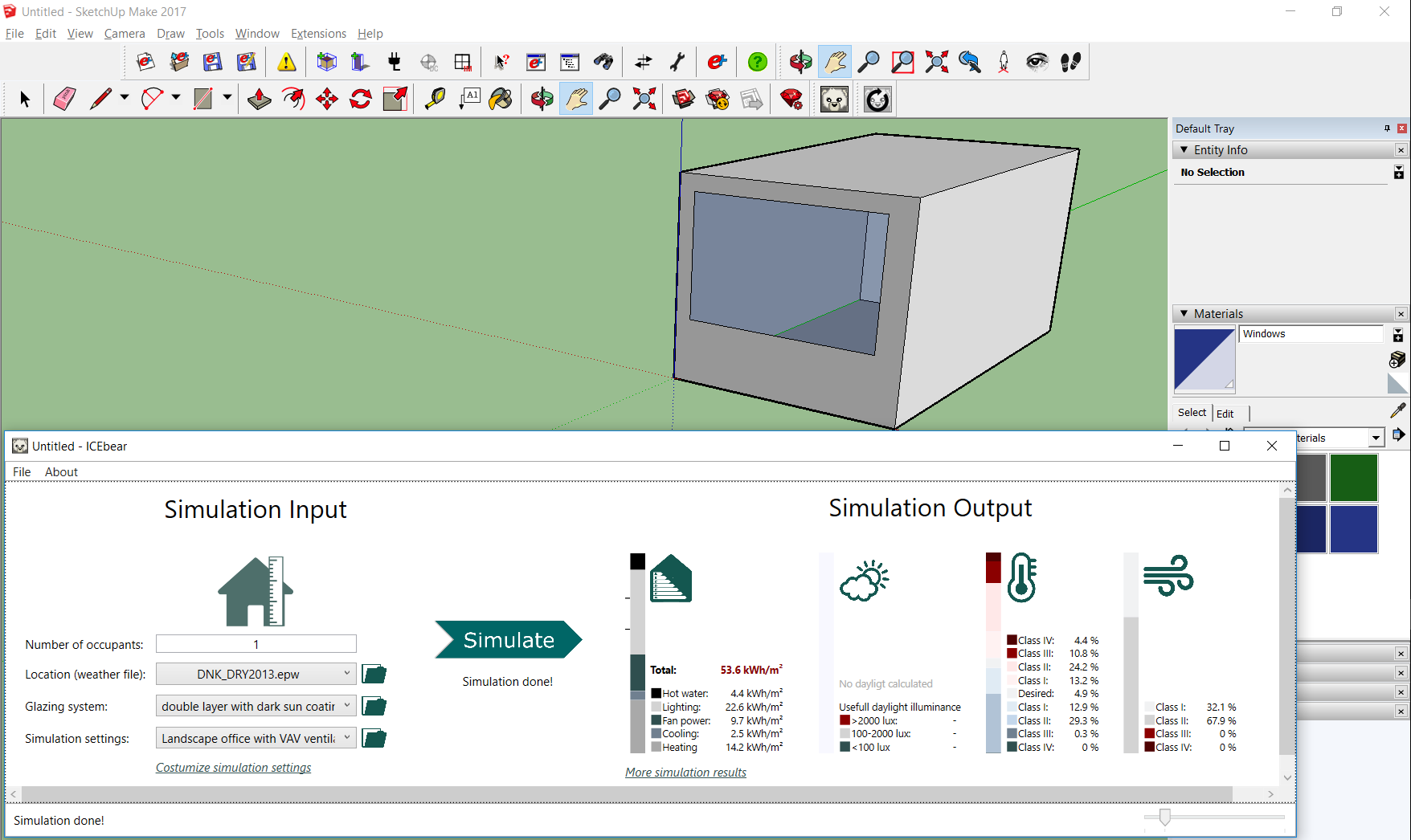The ICEbear project and tool is an attempt to contribute to the development of building energy modelling (BEM) in tools that are fit to conform to the design processes of the early stage. We strive to incorporate the following features in the development of ICEbear:
- Independent of the design process
The BPS tool must support a typical architectural design activity, i.e. support what architects actually do when they design – not dictate a certain process or workflow. - Fast and imbedded BPS modeling
Use geometrical data from architectural CAD models at a different level of detail, and make the BPS tool a plug-in to the CAD tool (no manual export of data). - All geometrical shapes are possible
No need for simplifying the architectural expression of the CAD model to enable BPS. - Independent of chosen CAD tool
The BPS tool should (at least) work in Rhino, SketchUp and Revit. - Differentiated input interface
Make the tool usable to non-experts who want to apply BPS by making simple interfaces for setting up simulation parameters (e.g. by using templates or wizards) but make all input variables accessible in another interface for the advanced user. - Fast versus precise simulations
The BPS tool for the early design stage should build on feasible tradeoffs between precision and simulation speed. - Intuitive visualisation of simulation results
Visualisations of simulation results should 1) be presented in a way that non-expert immediately can decode it 2) allow experts to assess the output in detail, and 3) support stakeholder collaboration. - Auto-generate documentation
An export function that generates reports containing input/output data for documentation purposes.

Example of ICEbear running in SketchUp
Nice to know...
- ICEbear is a FREE and OPEN thermal performance simulation tool for architectural design practice and research.
- ICE stands for (I)ndoor (C)limate and (E)nergy - bear is added because it initially was developed for Grasshopper...
- ...but it also runs with SketchUp and (soon) Revit.
Visit our Youtube channel for various instruction videos - Click here! (Still under development)
Technicalities...
ICEbear is developed following the research framework described in this journal paper:
Purup P.B., Petersen S. Research framework for development of building performance simulation tools for early design stages. Automation in Construction (2020) 109, 102966
The thermal simulation in ICEbear makes use of its own implementation of the resistance-capacitance known from EN 13790.
Documentation: Purup P.B., Petersen S. Rapid Simulation of Various Types of HVAC Systems in the Early Design Stage. Energy Procedia 122 (2017) 469-474
Solar heat gain is calculated using its own implementation heavily inspired by the EnergyPlus solar algorithm.
Documentation: Petersen S., Broholt T., Christensen L., Purup P.B. Thermal Performance Simulation of Complex Fenestration Systems in the Early Design Stage. 4th IBPSA-England Conference. Cambridge, England. 2018
Daylight calculations can be added for control of electrical lighting using e.g. DIVA or Honeybee in Rhino/Grasshopper. We will soon add a daylight simulation engine that enables daylight calculations in SketchUp as well.
ICEbear has some of unique features, e.g. the ability to simulate the thermal performance of dynamic facades systems represented by BSDF data - for further details see "Petersen S., Broholt T., Christensen L., Purup P.B. Thermal Performance Simulation of Complex Fenestration Systems in the Early Design Stage. 4th IBPSA-England Conference. Cambridge, England. 2018"
Weather data (in Danish as it is only about Danish weather)
Du kan downloade en .7z fil med DRY2013 vejrdatafiler, der er fremskrevet med klimaforandringsscenarier ved at trykke her (opdateret 10.11.2020).
.7z filen indeholder to mapper - en med DRY-filer i .epw format til indeklimasimuleringer og en med DRY-filer i Be18 format til energiberegninger. Der er også en.pdf fil med lidt mere forklaring om vejrdatafilerne og nogle beregningsresultater, der kan give en idé om hvor meget klimaforandringsscenariet kan betyde for bygningers varme- og kølebehov.
Har du spørgsmål, så skriv til Steffen Petersen, lektor, Aarhus Universtet,
Contact information
The development of ICEbear is managed by Aarhus University (AU), Department of Engineering, Section for Civil and Architectural Engineering. Main contributors in the development are AU researchers, students, and the industrial partner NIRAS A/S. We are always interested in feedback and collaboration.
Please email Steffen Petersen, associate professor, at Aarhus Universtiy, if you have questions, suggestions, or ideas for collaboration.